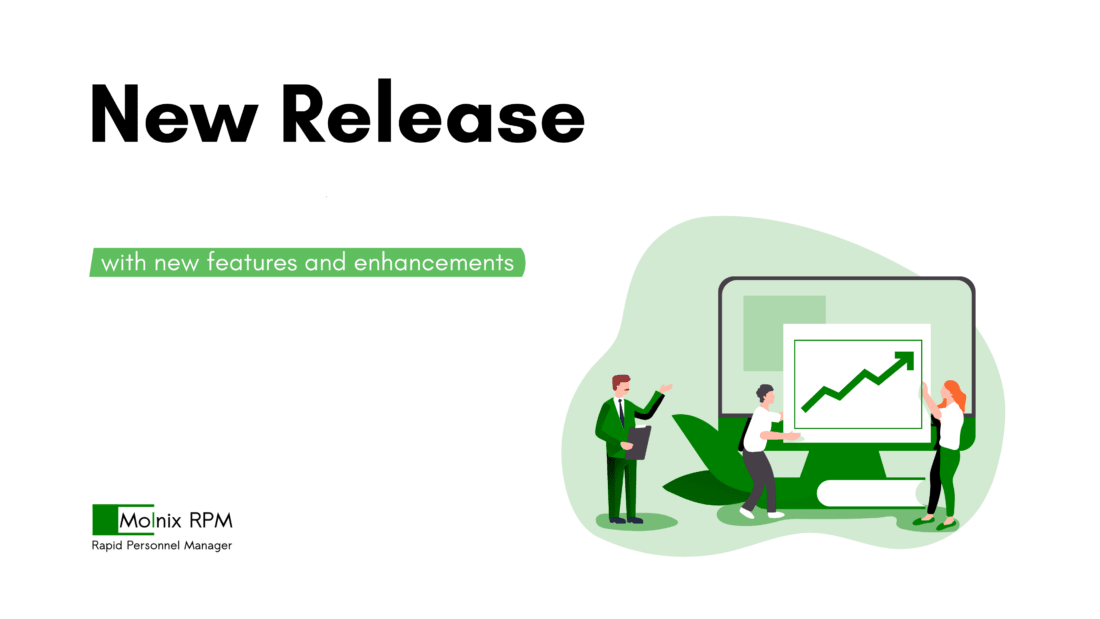 Rapid Personnel Manager
Rapid Personnel Manager
Molnix Rapid Personnel Manager receives major new features
This spring is without doubt one of the most exciting times for humanitarian HR, at least when using Molnix Rapid Personnel Manager. There are a long list of innovative new features just released and incoming over the coming months. In this post, I will explore the most prominent ones on our road map.
Released recently
Version 16.0 was the biggest release since our first public release. Usually we bump the major version whenever there is a new feature available. This time around, the list of new features deserving a major version bump would warrant pushing way beyond version 20 if we were to increment it once for each feature. The reason for pooling multiple features at once is our new user interface – all new features developed lately have been implemented only for the new interface.
New user interface
The new user interface, also know as the front end of the software, runs in the browser. This has huge advantages for performance, latency and features. We use a framework called Vue.js and the ecosystem that comes with it.
In the design, we have made an effort to keep it close to the old interface, to make the transition smooth. For the transition, we have three phases and have now entered the first one:
- Beta: the new interface is accessible on beta.<your normal address> alongside the old one on your normal address
- Fallback: the new interface is accessible on your normal address, and the old one on old.<your normal address> should you need it
- All-in: only the new interface is in use
Recruitment module
This module introduces a very powerful process engine along with new registers. Together they enable you to manage the full engagement lifecycle of staff. In order of usage, the new features are:
- Hires, to create staffing requests and manage their approval
- Positions, to open job advertisements and manage candidates
Boards module
A nice kanban view, to interact with ongoing hires and recruitment processes.
Process module
Build dynamic and automatic processes with:
- Processes, to use for applications and more
- Phases, to define process phases (represented as kanban columns)
- Actions, to automate your HR in the processes
Manager role
Scopes -driven role large organizations use to segment access rights. A scope is one or more tags, that define the accessible segment. A manager can have multiple scopes. Some example use cases:
- A manager of a specific technical sector can have a single scope, such as WASH
- A manager of a regional office can have a single scope such as AMERICAS
- A manager of multiple rosters, that may or may not overlap, can have multiple single-tag scopes such as MEDICAL and CCCM
- A manager who’s responsibility is a specific intersection of tags can have a sinlge multi-tag scope such as WASH+AMERICAS, and has access only to those records carrying both tags
- A user who needs access to the whole system, but not to master data would be a manager without scopes
When scopes are used, a default scope is selected to mark the tags to automatically apply when creating new records.
Automatic personnel record deletion
This feature in all simplicity, allows you to automatically prune personnel records from the database when they are considered expired. It prunes expired profiles, applications and related records based on your registry rules.
Upcoming in the near future
Over the following months, we are bringing a slow of features. Most of these will bump the major version as usual.
Workforce management module
This module will be incrementally expanded as demand rises. The first feature introduced is the availability calendar. It allows a quick overview of who is available at any given time. As such, it is an excellent tool for active stand-by rosters.
Intelligent alerts with positions
With the introduction of the recruit module, open positions can now be used in intelligent alerts.
Graded tags
Super easy management of tags that deserve level representation. Examples include language levels or tiered qualifications.
Proof of life
This feature allows roster members to securely set a proof of life, which can be accessed only by our customers, which triggers certain alerts.
For security experts: Molnix will encrypt the data using an asymmetric key created by the customer. Only the customer can decrypt the data. As such, Molnix can also not help with data retrieval in case of lost keys.
Deployment module
Contracts will be split into two modules: contracts and deployments. Contracts represent the private, salary and employment-related section. Deployment represents the operational functions. Deployments is also where interactions between organizations take place.
New tag automation features
A bunch of cool tag automation ideas have come up, most of these should find their way in:
- Organization and branch
- Passport expiry
- Country
- Course participation
Directory module
This module will provide rapid access to key contact information. Simple as that. Also, I hear one of our customers will use it the opposite direction: finding who has that lost SIM card 🙂 (yes, you will be able to search on the contact data as well).
Online course management
Online courses differ in many ways from on-site trainings. We will enable managing these in an easy manner.
Cloud federation
Last but definitely not least: cloud federation. This feature will deserve an annoucement of its own. However, the core is: customers and end-users will be able to share information between each other, in an integrated way. The key use cases to be covered are:
- Sharing alerts with other organizations: mobilize your partners without manual emailing and copy-pasting
- Integrated deployment seconding: propose your staff for deployment with your partner organization
- Basic personnel detail synchronizing for end-users: reduce need to update the same information to every database where you are a roster member
That’s it, nothing else on the horizon. End of list. Except all the stuff that we have not even imagined yet or that we keep under wraps to announce with big fanfare another time.
That beautiful road photo is from Finland, by Taneli Lahtinen.

